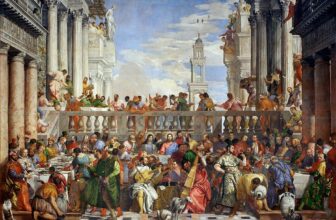
The Lost and Stolen Masterpieces of the Louvre in the 20th Century
The Louvre Museum in Paris is one of the most celebrated institutions of art and culture in the world. Housing a collection that spans thousands of years and includes some of humanity’s greatest artistic achievements, the museum is both a treasure trove and a target. While the Louvre prides itself on the preservation and security of its collection, it has not been immune to theft and loss. The 20th century, a period of great upheaval and change, saw some notable instances where paintings disappeared—either stolen or lost in the chaos of war and social movements. Here, we explore some of the most intriguing cases of lost and stolen artworks from the Louvre during this tumultuous century.
The Most Infamous Heist: The Theft of the Mona Lisa
No discussion of stolen artworks from the Louvre is complete without mentioning the audacious theft of the Mona Lisa. On August 21, 1911, the painting vanished, sending shockwaves across the world.
The culprit? An Italian handyman named Vincenzo Peruggia, who believed the artwork rightfully belonged in Italy. Peruggia had hidden inside the museum overnight, disguised himself in a white smock worn by Louvre employees, and simply lifted the masterpiece from its frame. He walked out of the building with it tucked under his coat.
For over two years, the painting was missing, sparking widespread speculation. Some suspected famous artists, including Pablo Picasso, while others believed it had been lost forever. However, in 1913, Peruggia attempted to sell the painting to an art dealer in Florence, leading to his arrest. The Mona Lisa was returned to the Louvre, and the heist only added to its legend.
The Nazi Plunder and World War II Losses
During World War II, the Louvre, like many European museums, became a battleground for cultural preservation. As Nazi Germany occupied France, the risk of art theft and destruction grew exponentially. Under the leadership of Jacques Jaujard, the museum took preemptive action, secretly relocating thousands of its artworks, including the Mona Lisa, to the countryside.
Despite these efforts, some paintings were still seized by the Nazis. One such loss was “Portrait of a Young Man” by Raphael, taken as part of the infamous Nazi looting operations. While not stolen directly from the Louvre, its disappearance during the war underscores the vulnerability of even the most revered institutions.
Many artworks stolen by the Nazis were recovered after the war, thanks to the Monuments Men, a group dedicated to locating and restoring looted cultural property. However, some pieces remain missing, their fates uncertain.
The 1971 Robbery: Courbet and the Unsolved Mystery
The 1970s saw another high-profile theft from the Louvre, this time involving a work by the French painter Gustave Courbet. In 1971, Courbet’s The Wave was stolen in a robbery that baffled authorities. Unlike the Mona Lisa heist, this crime did not have an ideological motive or a nationalist agenda. Instead, it appeared to be a calculated effort by professional thieves.
Although numerous investigations were launched, the painting has never been recovered. Some speculate it ended up in the hands of a private collector, hidden away from the public eye. Others believe it may have been destroyed to prevent detection. To this day, the disappearance of The Wave remains an open case, adding another layer of mystery to the Louvre’s history.
The Mysterious Vanishing of Chardin’s Still Life
Jean-Baptiste-Siméon Chardin, an 18th-century master of still life, was known for his ability to transform everyday objects into works of profound beauty. One of his paintings, a delicate still life featuring fruit and a carafe, vanished from the Louvre’s collection under murky circumstances in the 20th century.
Unlike high-profile thefts that involved break-ins or organized crime, Chardin’s painting seemed to have disappeared without a trace. Some believe it may have been misplaced in the vast archives of the museum, while others suspect it was stolen in a manner so discreet that it went unnoticed for years. The lack of definitive evidence makes this one of the more enigmatic losses in the Louvre’s history.
The 1983 Attempted Theft: Security Under Scrutiny
In 1983, an attempted robbery of the Louvre highlighted weaknesses in the museum’s security measures. A gang of thieves attempted to steal Eugène Delacroix’s Liberty Leading the People, a masterpiece depicting the 1830 revolution. The thieves, however, were foiled before they could make their escape, and the painting was recovered without damage.
The attempt was a wake-up call for the museum, prompting a review of its security protocols. New measures, including advanced surveillance systems, were introduced in the years that followed, making thefts less frequent and more difficult.
The Challenge of Recovering Stolen Art
Recovering stolen art is a daunting task. When a painting is taken, it often disappears into a shadowy world of illicit collectors and black-market dealings. Unlike jewelry or gold, which can be melted down, famous paintings retain their identities, making them difficult to sell openly. This has led to some bizarre cases where thieves have returned stolen paintings after realizing they were too recognizable to profit from.
Interpol, the FBI, and numerous other international agencies continue to track stolen artworks, and occasionally, long-lost pieces resurface. In some cases, paintings have been recovered decades after their disappearance, hidden in private collections or forgotten storage facilities.
Strengthening Security in the Louvre
The 20th century saw the Louvre refine its approach to protecting its vast collection. Today, the museum employs cutting-edge technology, including motion detectors, infrared cameras, and biometric scanning, to prevent theft. However, history has shown that no security system is entirely foolproof, especially when facing determined criminals.
Beyond technology, collaboration with international law enforcement and increased vigilance among museum staff have played a crucial role in preventing further losses. The lessons learned from past thefts continue to shape how museums worldwide safeguard their treasures.
The Louvre’s Enduring Legacy
Despite the thefts and losses it has endured, the Louvre remains a symbol of artistic and cultural resilience. While some paintings are still missing, efforts to recover them continue, driven by historians, detectives, and art lovers around the world.
Every missing painting carries a story, a story of ambition, crime, and sometimes, redemption. As art lovers walk the halls of the Louvre, gazing at masterpieces that have survived wars, heists, and the passage of time, they are reminded of the museum’s extraordinary history. While some of its treasures remain lost, their legacies endure, whispering through the corridors of one of the world’s greatest cultural institutions.




